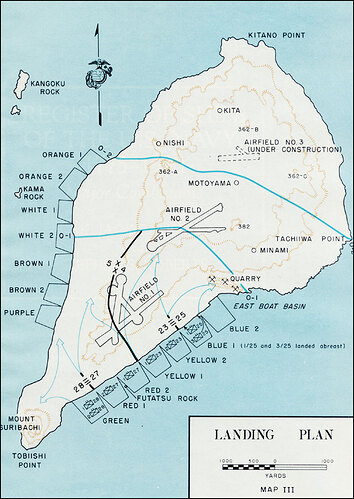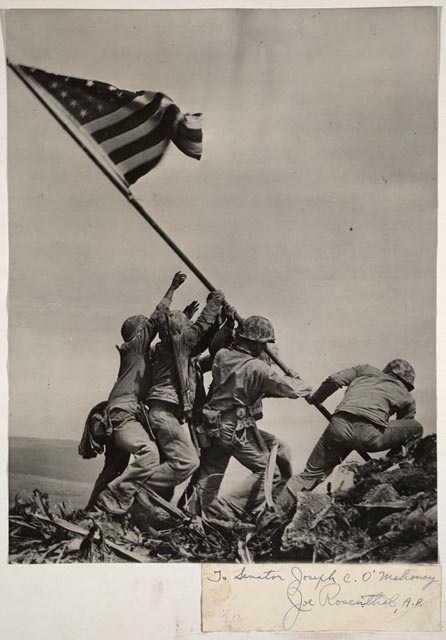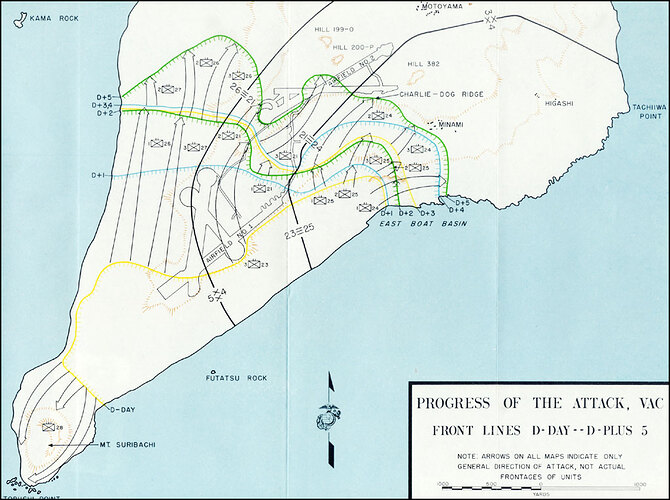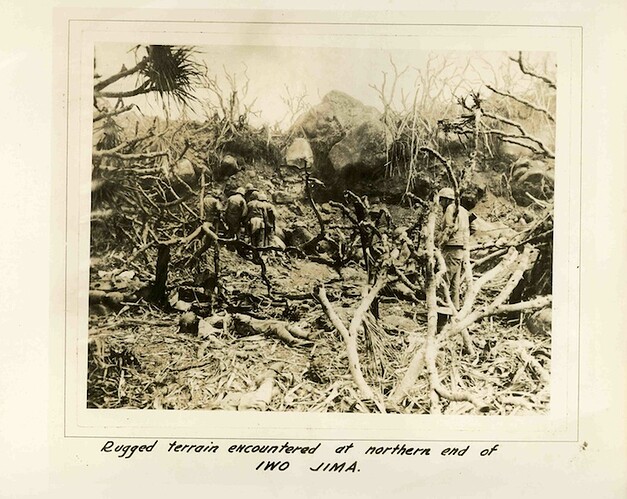Thank you Texag57, great idea… Let me suggest to put at least also here the pictures, so that they could to come along the text, the veteran’s memory.
:)Thank you for the suggestion, DVX. I had thought about that, but was not sure about how to do it. I’ll experiment a little to find the way. :army:
It would be amazing to post some original pics made after the landing by Mr. Clyde Jackson or by some of his mate, but they weren’t probably in the right mood to shoot pictures, after the hell they had to face… It would be nice, but i have the feeling that we’re asking too much… His availability to share his remembrances wit us, is more than enough… Thanx again.
Thanx again.
I really doubt that he has any personal photos, but later he will mention about being nearby when someone else took a picture, but he was not in it. Remember, his battalion’s objective was Mt. Surabachi.I will inquire of him if he has any photo’s, however. I do have a photo of another U.S. Marine friend, who has now passed away. He was on Okinawa, where he was heading a demolition team. He had some experiences he shared with me, but I do not have them written down, unfortunately.
[b][i]Episode 4: The approach to Mt. Surabachi.
The first day and night were very critical as we had to make sure we were well organized to withstand a banzai attack, which never came in full force. I later learned the General Kuirbayashi did not believe in expending his troops in such a manner. The Navy did a great job every night by firing star shells and parachute flares so we (could) observe any movement by the Japanese.
The second, third and fourth days all seem to run together in my memory. The same thing every day, attacking pillboxes, caves and tunnels all the while being pounded by gunfire pouring down on us from Suribachi. We thought it would never end.
But, there is always one memory that stands out. Prior to night falling on the second day, a defense line was established , and our company, Co. F, had the defense from the water line inland. Two other men and I were digging a foxhole when I struck something metallic-I knew it was a land mine, but all I could think was, “Damn! We’ll have to start a new foxhole”. I slipped my hand under the mine to see if it had a trip wire. It had none, so I picked it up gently and placed it about 6 yards behind us. I never told the other men until later that night. I’ve done some dumb things, but this was the dumbest. Dumb was not one of the words my buddies used when I told them what I had done.
Again, we had no banzai attack, but we had a terrific 240 mm. mortar attack along our line, starting in front of us and marching all the way down to the landing beach.
One of the men with me suffered a very painful shoulder wound-we did what we could to help him, and we were able to get him evacuated before we starting pushing forward that morning. I felt sorry for the troops, especially the wounded that were caught in the mortar attack on the landing beach that night because many of the wounded who were waiting to be evacuated were wounded again or killed. Much equipment and supplies were destroyed.
By the end of the 4th day we had reached the base of the mountain and surrounded all sides just prior to nightfall, except where the mountain ran directly into the ocean. We were still encountering pillboxes and caves, but at least the mortars and artillery could not reach us.
Next: Assault on Suribachi.
[/i][/b]
Thank you, texag57. And please pass on my gratitude to your friends. This is exactly why I love this forum!
:)I appreciate your note, colmhain. All credit goes to Clyde Jackson, who wrote this up as a talk to different organizations, and was nice enough to give me a copy to share. More to come.
A map showing the landings of the 1st and 2nd battalions lower left.I thought this might give the reader a visualization of the path Clyde would be taking during the battle.
:DThanks so very much rudeerude. Can you coach me on how to add pictures and maps? I see the tool for “image” but do not know how to use it. Thanks , again for the map.
[b][i]Episode 5: Mt. Suribachi
Again we set up our defense for the night, expecting an attack, but no serious attack came, but there was fighting all night.
The morning of the 5th day was almost totally quiet, except for the fighting at the other end of the island. A patrol was ordered to climb Suribachi, and my squad leader and 3 other men climbed to the top and returned, reporting seeing only dead Japanese. A 40-man patrol from E company was ordered up Suribachi carrying the first flag that was raised-the entire battalion followed, and when I reached the top, what an incredible sight it was to see the entire island. It made me realize how important it was to capture Suribachi. Because the first flag was so small, a much larger flag was brought up, and I was standing about 6 feet from Joe Rosenthal when he took his famous picture of the 2nd flag being raised. It was great to see the flag, but all I could think of was that I was alive. (Clyde told me personally about three weeks ago, when we were together, that if he had known how famous that picture would be, he would have run over to help the guys raise it!) Who would have ever guessed what an Icon that picture would become?
We later found out that most of the Japanese on Suribachi had either committed suicide; filtered through our lines during the night, or escaped through the tunnel system to the north end of the island to fight again.
We spent the night on top of Suribachi and then spent the next two days rearming, resting, and blowing up tunnels and caves we had bypassed earlier when pressing the attack on Suribachi.
We thought we were through fighting, because we had achieved our objective, but a strange thing happened. We started getting replacement troops-our first clue we weren’t going anywhere but north.
Next episode: The Fight in the North End of Iwo Jima:neutral:
[/i][/b]
Hi Texag57,
thanx again for your friend Clyde’s story. I’ve seen in your previous post that you asked some help about how to include pics and maps in your posts…
If you allow me to give a little help i’m going to explane to you how i posted the picture above, just like an example, step by step… First of all i saved the pic of the “US Flag raisin” on my PC Desktop with the name “Iwo Jima”. After you wrote your message you have to make a click on the ATTACHMENTS icon (center-top). In the box that appears, make another click on ADD FILES icon. After this make another click on SELECT FILES. It’ll appears a new box related to your PC. Select DESKTOP (where the picture’s been saved) and then select IWO JIMA. After this, select OPEN and then UPLOAD FILES. Just wait few seconds and you’ll see your picture in the low left corner. Select DONE and the play’s done… Now you can see your post with the picture you selected…
Thanks very much for your help. I have printed the information you sent me, and I will give that a try a little later this evening. I am going to try to get Clyde to get on this site. He is now 85 and very sharp, so he might give it a go. I’ll let him know that several of the members are enjoying his Iwo Jima adventure.:army:
E Company taking the first flag up Mt.Suribachi
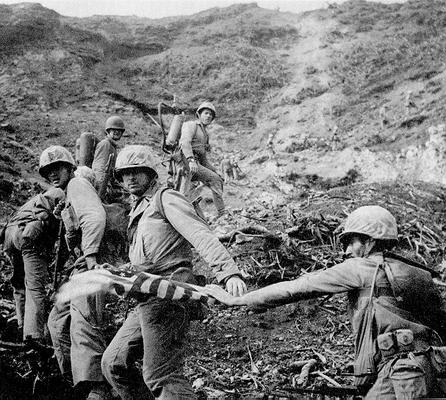
A map showing the progress of the Marines D-day +5 it also shows the 28th regiment.
Your welcome texag57 ;).I have been enjoying this thread very much with the reading’s
That is so cool to have the pictures to go with Clyde’s story. Thanks very much.
There is not enough time to tell about all of the fighting our regiment encountered, but let me give you an example.
One of the most fortified areas on Iwo Jima was Hill 362A and Nishi Ridge. Our sister regiment had been attacking these two strong points and had incurred so many casualties that they had to be relieved, and the 28th took their position. Now Hill 362A was not really a hill but an eighty foot cliff completely interlaced with caves and tunnels, all fitted out with machine guns, mortars, and artillery. Two hundred fifty yards to the north was Nishi Ridge, equally heavily defended. Our 1st Battalion attacked the cliff, and our 3rd Battalion attacked the ridge. Our 2nd Battalion attacked the field in between. The other two battalions probably had the most difficult positions, but our battalion was caught in a cross fire from both the cliff and the ridge.
We lost 96 men in the first 5 hours of fighting. The fight raged on for another three days and nights before we captured both positions. One of my most vivid memories I had of the first day was when I was running next to my squad leader when he was wounded. As he was falling, I grabbed him and pulled him down into a very large shell hole, probably made by one of our battleships. I opened his dungaree top and I could see the hole in the side of his chest. The only thing I could do was pour sulfa on it and put a patch over it. The Japanese knew where we were and would fire mortars at us when they did not have another target. One mortar shell hit the upper rim of the shell hole we were in, burying itself in the soft sand before exploding with all the force going up, but covering (us) with sand. The battle continued until late afternoon when things quieted down enough so we could remove all of our wounded and reclaim our dead. I didn’t see my squad leader for fifty years and when we did meet the first thing he asked was did I remember what I said to him when he was wounded. I did not. He quoted me, " you are going to be OK, Sherman—I think"!!
Episode 7: The Battle Ends/The Role of the Navy[/i][/b]
Good job, Texag57!!! Nice to hear that Sherman survived the war, too… 
Nice story, thanx again!
Another good short read texag57.I will be looking forward to the next episode and hopefully many more.Good to see you have the photo situation figured out.A perfect example to go with the story.
 That was good news about Sherman, wasn’t it. I was glad to see that in Clyde’s notes as well. Clyde did a great job in writing his story. I will try to get more, if possible. He and I live in two different parts of Texas, but I hope to visit him again. His being in the 4th Marines means he fought at other islands in the War.
That was good news about Sherman, wasn’t it. I was glad to see that in Clyde’s notes as well. Clyde did a great job in writing his story. I will try to get more, if possible. He and I live in two different parts of Texas, but I hope to visit him again. His being in the 4th Marines means he fought at other islands in the War.
Thanks, rudeerude, it took me awhile, but I think I finally have the hang of posting pictures. I know that Clyde fought at other islands in the Pacific, and I will see if he wishes to write any more of his experiences. I did have another good friend at our church in Houston that was in the 2nd Marines, but he passed away recently. He had been at Tarawa and Okinawa, just to name a couple of places he fought. He was head of a demolition crew that had to blast the Japanese out of their caves, or seal them in.

